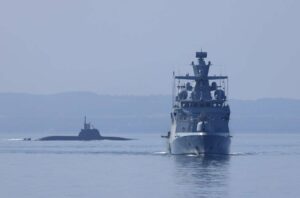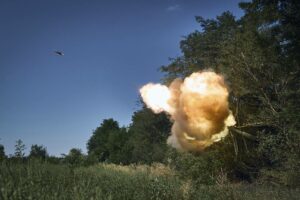MILAN — Estonian officials have announced what could prove to be the most expensive defense investments ever made by the Baltic country, as leaders embark on an updated modernization plan shaped in large part by Russia’s invasion of Ukraine.
According to figures presented by the defense ministry in Tallinn, the government wants to spend roughly $14.5 billion over the next ten years, a sum derived from a new threat assessment of Estonia’s wider environs, the Baltic Sea region.
The spending would increase Estonia’s share of defense spending to to 3% of gross domestic product for 2024-2027, up from approximately 2.85% this year. An additional $1.1 billion has also been allocated to the budget specifically for ammunition. Overall, the financial distribution of military costs for 2023-2026 foresees that 54% will be spent on procurement.
Gen. Martin Herem, the commander of Estonia’s forces, ticked off a wish list of weapons during a press conference last Friday that are already, or will be, part of the country’s National Defence Development Plan 2022-2031.
A number of the listed acquisitions come from Israeli manufacturers. These include the Harpy long-range loitering munitions, manufactured by Israel Aerospace Industries (IAI), which Estonia will start to receive next year.
At the announcement of that contract earlier last month, Estonian defense minister Hanno Pevkur stated that the addition of such weapons to their arsenal was critical.
“The importance of indirect fire cannot be overestimated, since Russia has caused much of the destruction in Ukraine through this. … Their introduction [will] allow us to attack the enemy from a longer distance,” he said.
Estonia will also acquire additional anti-tank capabilities over the next two years, including the Spike missile, in the short-range version for its brigades and long-range model for its territorial defense. Made by Israel’s Rafael, the weapon is sold in Europe by Eurospike GmbH, whose shareholders are Diehl Defence, Rheinmetall Electronics and Rafael-owned ERCAS BV.
As for the Estonian Navy, Herem mentioned that the anti-ship “Blue Spear” land-to-sea missiles will be used for coastal defense. The weapons are slated for delivery by the end of 2023 and ready for use in the first half of next year. The missile is a product of Proteus Advanced Systems, a joint venture between IAI and Singapore’s ST Engineering Land Systems.
Notably, the Estonian government last year changed its policy towards Israel by deciding to no longer vote for UN resolutions condemning Tel Aviv’s actions in the West Bank and Gaza Strip. At the time, the move was largely deemed by analysts as an attempt by the Baltic country to align itself further with the United States.
RELATED

The Estonian general emphasized that two Estonian brigades will receive 36 K-9 155mm self-propelled howitzers by 2026, of which 18 are already in Estonia. The $38.9 million contract for these twelve additional systems went to South Korean arms manufacturer Hanwha Defense in January.
Envisioned army capabilities also include light grenade launchers from Spain-based maker Instalaza and new armored personnel carriers for the 2nd Infantry Brigade, where they will replace trucks, Herem said.
For almost two decades, the army has relied on the Finnish-made Patri Pasi APCs. Last year, the Estonian Center for Defense Investment said that a procurement of 220 wheeled armored vehicles, worth approximately $215.4 million, was accelerated following the Ukraine war. No confirmed manufacturer has been named thus far for this.
By 2025, the Estonian army will also have several HIMARS rocket launchers, a signature weapon of the Ukraine war that has helped repel Russian forces. Tallinn has contracted with Lockheed Martin for the supply of six systems.
Most of Estonia’s focus in the air domain appears to be placed on improving the surveillance and communication systems, with air defense radars scheduled to be replaced by 2027.
The government also awarded Polish company Mesko a contract last September to provide 300 missiles and 100 launch mechanisms of the portable anti-aircraft missile system Piorun. The air defense weapon is designed to destroy low-flying aircraft, including helicopters and drones.
“The first deliveries of PIORUN will take place this year, with the last ones expected in 2025,” Harem said.
In light of deepened cooperation with Poland, Estonia also recently signed a seven-year framework contract of $5.6 million with Polskie Zaklady for the purchase of spare parts, equipment and supplies for the PZL M-28 Skytruck transport aircraft it operates.
The Baltic country is also confident that it will be able to deploy the German medium-range air defense system IRIS-T come 2025, following its joint procurement with Latvia announced last month.
Besides buying new weapons, military leaders want to increase the size of the armed forces from 26,000 to 36,000 troops before the end of this year.
Elisabeth Gosselin-Malo is a Europe correspondent for Defense News. She covers a wide range of topics related to military procurement and international security, and specializes in reporting on the aviation sector. She is based in Milan, Italy.
- SEO Powered Content & PR Distribution. Get Amplified Today.
- EVM Finance. Unified Interface for Decentralized Finance. Access Here.
- Quantum Media Group. IR/PR Amplified. Access Here.
- PlatoAiStream. Web3 Data Intelligence. Knowledge Amplified. Access Here.
- Source: https://www.defensenews.com/global/europe/2023/06/13/estonias-global-arms-buying-spree-seeks-drastic-combat-gains/
- :has
- :is
- :where
- $UP
- 000
- 1
- 10
- 100
- 2023
- 2025
- 2026
- 220
- 26
- 300
- 70
- 9
- a
- Able
- accelerated
- acquire
- acquisitions
- actions
- addition
- Additional
- advanced
- Aerospace
- AIR
- aircraft
- align
- allocated
- allow
- already
- also
- ammunition
- an
- Analysts
- and
- announced
- Announcement
- approximately
- ARE
- armed
- arms
- Army
- Arsenal
- AS
- assessment
- At
- attack
- aviation
- awarded
- Bank
- based
- BE
- been
- before
- between
- Billion
- budget
- Buying
- by
- cannot
- capabilities
- carriers
- caused
- Center
- changed
- combat
- come
- Communication
- company
- Conference
- confident
- CONFIRMED
- contract
- cooperation
- Costs
- could
- country
- country’s
- covers
- critical
- decades
- Deciding
- deemed
- defence
- Defense
- Deliveries
- delivery
- deploy
- Derived
- designed
- destroy
- Development
- distance
- distribution
- domain
- Domestic
- Drones
- during
- Earlier
- Electronics
- embark
- emphasized
- end
- Engineering
- equipment
- estonia
- Europe
- EVER
- expected
- expensive
- false
- far
- financial
- Fire
- First
- Focus
- following
- For
- Forces
- Framework
- Friday
- from
- further
- Gains
- General
- German
- Global
- GmBH
- Government
- gross
- Half
- Have
- he
- helicopters
- helped
- http
- HTTPS
- image
- images
- importance
- improving
- in
- include
- Including
- Increase
- industries
- International
- Introduction
- invasion
- investment
- Investments
- Israel
- Israeli
- IT
- Italy
- ITS
- itself
- joint
- joint venture
- jpg
- Korean
- Land
- large
- largely
- Last
- Last Year
- LATVIA
- launch
- leaders
- light
- List
- Listed
- Lockheed Martin
- longer
- made
- maker
- manufactured
- Manufacturer
- Manufacturers
- Martin
- mechanisms
- mentioned
- MILAN
- Military
- million
- ministry
- missiles
- model
- modernization
- Month
- most
- move
- much
- Named
- National
- New
- news
- next
- no
- number
- of
- off
- officials
- on
- ones
- operates
- or
- over
- overall
- part
- parts
- Personnel
- Place
- plan
- plato
- Plato Data Intelligence
- PlatoData
- Poland
- policy
- Polish
- presented
- press
- Product
- Prove
- provide
- purchase
- Rafael
- range
- ready
- receive
- recently
- region
- related
- replace
- replaced
- Reporting
- rocket
- roughly
- Russia
- russian
- Said
- scheduled
- Screen
- SEA
- sector
- security
- Seeks
- September
- several
- shaped
- Share
- Shareholders
- she
- signed
- since
- Singapore’s
- SIX
- Size
- sold
- South
- south korean
- specializes
- specifically
- spend
- Spending
- spent
- spike
- start
- stated
- States
- Strip
- such
- supply
- surveillance
- system
- Systems
- Take
- Tallinn
- Tel
- ten
- that
- The
- The West
- their
- These
- they
- this
- this year
- threat
- Through
- time
- to
- Topics
- towards
- transport
- Trucks
- two
- Ukraine
- ukraine war
- UN
- United
- United States
- updated
- us
- use
- used
- Vehicles
- venture
- version
- Vote
- want
- wants
- war
- was
- Weapons
- went
- West
- What
- which
- whose
- wide
- Wide range
- wider
- will
- with
- worth
- would
- year
- years
- zephyrnet












